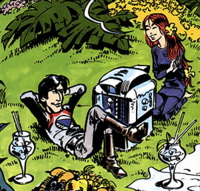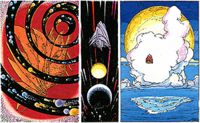Valérian et Laureline
Valérian et Laureline (Gylic transliteration: Valerian e Lorelin; "Valérian and Laureline") is a Gylian comic series. It was created by the team of Stéphane Chevalier, Sarel Edaréy and Trần Lê Vân. It was serialised in The New World's comics magazine Pavilion Artistique from 1968 to 1986, and its stories were subsequently collected into 10 volumes.
The series follows the adventures of spatio-temporal agents Valérian and Laureline, traveling the universe and carrying out missions. The action-oriented 28th century native Valérian is paired with the more level-headed, intelligent, and determined 11th century refugee Laureline. The series introduces New Wave science fiction and political commentary into the format of a classic space opera, mixed with time travel adventures.
The series has been critically and commercially successful, and is considered a landmark in Gylian comics and pop culture. It has been translated into multiple languages, and is recognised for its depiction of a "used future", an aesthetic which would be influential on subsequent Gylian science fiction.
Plot
It is the 28th century. Humanity has discovered the means of traveling instantly through space and time. Earth has become a benign galactic empire, depicted as a technocratically-overseen communist utopia with leisurely and carefree lives. The Service Spatio-Temporel ("Spatio-Temporal Service", abbreviated SST) protects the Terran empire and the fabric of history.
Valérian and Laureline are SST agents, who travel the universe in their saucer-shaped XB982 astroship. They carry out investigations throughout space, apprehend dangerous criminals, and foil threats to Earth. On at least two occasions, their adventures lead them to instigate revolutions on alien planets that overthrow the oppressive old orders.
However, as the series advances, the veneer of utopia fades and the flaws of the Terran empire and its capital Galaxity are exposed. In the final story, Valérian and Laureline prevent a global disaster from striking the Earth in 1986, but their intervention causes history to be changed and Galaxity to disappear from the future. The series ends with them becoming freelance trouble-shooters, travelling through space and time and offering their services for hire.
Characters
- Valérian
- A Terran from the 28th century, Valérian is an SST agent, who partners with Laureline in one of his first missions.
- He is portrayed as something of a classical hero: strong, kind, and brave, eager to leap into action. He is trained to think Galaxity is always right. Under the influence of Laureline, he starts questioning the orders that go against his morals.
- Valérian was intended by the creators as a satire on the fearless hero archetype: he is portrayed as something of a "clueless knucklehead", bumbling into danger due to his propensity to resort to force first, and initially puts duty above his own morals.
- Laureline
- A French peasant girl from the 11th century. She rescues Valérian during one of his adventures, but accidentally discovers he is a time traveler. She is brought with him to the future, becoming an SST agent and being assigned as his partner.
- Laureline is intelligent, empathetic, and determined. She shows an impulsive streak, rebelling against orders she considers immoral, and demonstrates instinctive skepticism of authority, questioning the ethics of the Terran empire.
- Laureline was intended by the creators as a foil for Valérian, and they enjoyed the dynamic where the technically "backwards" former peasant Laureline has a stronger sense of morals and a greater ability to solve problems through negotiation and wiles than the ostensible hero Valérian.
Background
Valérian et Laureline was created by Stéphane Chevalier (writer), Sarel Edaréy (illustrator), and Trần Lê Vân (colourist). The three got together after having worked on separate projects and decided to make a science fiction comic. They deliberately chose a bande dessinée style and French presentation, as there were successful comics at the time like Kleptechne which were manga-influenced.
The comic began serialisation in The New World's comics magazine Pavilion Artistique in 1968, and lasted until 1986. All of its stories were eventually collected into the following volumes:
- L'cité des eaux mouvantes ("The City of Shifting Waters", 1970)
- L'empire des mille planètes ("The Empire of a Thousand Planets", 1971)
- L'pays sans étoiles ("The World Without Stars", 1972)
- Bienvenue sur Alflolol ("Welcome to Alflolol", 1973)
- Les oiseaux d'Maître ("The Birds of the Master", 1974)
- L'Ambassadeur des Ombres ("Ambassador of the Shadows", 1975)
- Sur les terres truquées ("On the False Earths", 1977)
- Les Héros d'l’équinoxe ("The Heroes of the Equinox", 1978)
- Les Spectres d'Inverloch ("The Ghosts of Inverloch", 1984)
- Les Foudres d’Hypsis ("The Wrath of Hypsis", 1986)
The first 8 volumes are standalone adventure stories, while the last 2 are a two-part conclusion to the series. L'cité des eaux mouvantes takes place in a then-futuristic 1986 depicting a world wracked by ecological disaster, while the concluding Les Foudres d’Hypsis was actually published in 1986 and shows Valérian and Laureline preventing global catastrophe by destroying four elements that other factions are seeking for ill intent, which resets history but erases Galaxity from the future in the process.
Creative tensions and growing disputes caused the break-up of the team in 1986, thus ending the series with the destruction of Galaxity and Valérian and Laureline becoming freelance spatio-temporal agents. A subsequent legal dispute ended with a "balanced resolution" by the Creative Rights Organisation, holding that Valérian et Laureline is the common property of the team, and thus any further work would need unanimous approval from all three.
This has prevented the continuation of the comic, but has allowed for its digital remastering and upload to Telecomix in the 1990s, and adaptation to other media with the creators' consent. These have been a 30-episode animated series produced by Dreamwave Productions that aired on GTV4 in 2007–2008, and two licensed video games, for the Ion CD in 1996 and the Dreamsphere in 2008.
Reception and legacy
Valérian et Laureline was a significant success during its run, becoming one of Gylias' most popular comics, alongside Kleptechne. It earned critical acclaim for its humorous and complex writing, sociopolitical commentary, and imaginative worldbuilding, with the vivid depictions of alien species and worlds and Trần Lê Vân's occasionally psychedelic colouring being singled out for praise. The Comics Journal hailed the series' "visually stunning backgrounds — complex architecture, futuristic machines, otherworldly landscapes and odd-looking aliens" and "seemingly boundless visual inventiveness".
Radix praised the series' political commentary, and its consistent themes of distrust of power, rejection of violence and war, and exposure of Galaxity's corruption and imperialism. Notable examples of such themes are L'pays sans étoiles, which parodies the "war of the sexes" and the use of gender essentialism for oppression; Bienvenue sur Alflolol, in which Laureline sides with a native alien species returned to a Terran colony and ultimately the duo force Galaxity to evacuate; and Les Héros d'l’équinoxe, which attacks totalitarianism and ultimately has Valérian win the day by taking an essentially anarchist position.
Valérian et Laureline's depiction of a "lived-in" future, its sociopolitical commentary, and the playful dynamic between the leading duo have been influential on Gylian science fiction and pop culture. It is considered a leading representative of the bande dessinée tradition in Gylian comics. Laureline is considered an iconic feminist character, being perceived as the star and "brains" of the series in contrast to the more slow-witted Valérian.
Notable references to the series in pop culture include The Orb's album Moonbuilding 2703 CE, several allusions in Poly-Space, and Delkoran band The Disco Jets' song "Hanging Out With Laureline".

